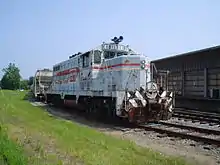|
|||
|
| Glossary |
| HKeys-CM |
| HKeys-DVR |
| HKeys-SUR |
| HKeys-WIN |
| Mouse use |
| Notations |

KIND Engine assets are classified as rolling stock which contain diesel or electric loco engine performance characteristics. The related sister-KIND or class asset is kind steam-engine which uses many if not all of the same (sub-)containers or Child classes listed below, but has a different pallet of base data which needs be modeled and defined in the parent class (i.e. the container 'KIND Engine'—those tags and special KIND containers discussed here below). This modular breakout should make working with configs easier for the new and old Trainzers to get a handle on.
Historical engine-specs
Formats of engine specifications evolved from the earliest Trainz versions, perhaps more than any other digital modeling group of assets, which is readily understandable given the dependency of a locomotive's driving behavior (the physical reality modeled and simulated in a digital virtual world) depend more than any other class of object on tight interaction between scripting, animation elements, and the physics model within Trainz. Unfortunately, the older Content Creator's Guides (early era, HTML pages and files, after UTC as *.pdf files) were also generally kept online for ease of updating, and cannot now*[notes 1] be readily accessed by new comers or others interested in comparing different digital models.
|
The containers and gross changes in engine-specs may be compared to the current grouping of tags and containers by seeing the CCGTC Online page: Kind: Engine.
KIND Hierarchy
| [e ] |
| KINDs (type asset groups) and containers |
|---|
|
Parent Classes
Child Classes-containers
The engine child data structures are termed containers in Trainz and each defines the parameters and variables the simulator software needs to produce a dynamic working 3D asset.
- throttle-power container
- dynamic-brake container
- pressure container
- mass container
- motor container
- flowsize container
- volume container
Supported Tags
kind "engine"
throttle-power
{
}
dynamic-brake
{
}
pressure
{
}
mass
{
}
motor
{
}
flowsize
{
}
volume
{
}
scale ""
epbrakes "" (Obsolete tag)
autopilot-stop-distance 5.0
autopilot-crawl-distance 20.0
autopilot-caution-speed-multiplier 0.5
throttle-adjustment-rate 0.01
throttle-power
- Type: throttle-power Container
- Desc: Acceleration variables in cabin mode.
dynamic-brake
- Type: dynamic-brake Container
- Desc: Deceleration variables while dynamic braking in cabin mode.
pressure
- Type: pressure Container
- Desc: TBD
mass
- Type: mass Container
- Desc: TBD
motor
- Type: motor Container
- Desc: TBD
flowsize
- Type: flowsize Container
- Desc: TBD
volume
- Type: volume Container
- Desc: TBD
scale
- Type: Obsolete
- Desc: Obsolete
epbrakes tag
- Type: Obsolete single value
- Desc: Obsoleted in release of TS2009
- Corrective action: Move into description block text or delete line.
autopilot-stop-distance
- Type: float
- Desc: How far (in meters) in front of a typical obstruction (red light, etc.) the AI will attempt to stop the train. Changing this value can help fine-tune the accuracy of the AI's movement, however attempting to make the train stop too close to a target may result in overruns in some cases. This tag is intended for special-case usage only.
autopilot-crawl-distance
- Type: float
- Desc: Once this distance (in meters) from the intended stopping position has been reached, the AI will 'crawl' rather than attempt to speed up to reach its destination. Changing this value can help fine-tune the accuracy of the AI's movement, however attempting to make the train stop too close to a target may result in overruns in some cases. This tag is intended for special-case usage only.
autopilot-caution-speed-multiplier
- Type: float
- Desc: The AI will slow to this multiple of the speed limit when operating under caution conditions. This can be set to 1.0 in order to effectively remove caution-speed driving, however this can increase the risk of overruns in some cases
throttle-adjustment-rate
- Type: float
- Desc: Defines the adjustment rate at which the engine's throttle will adjust to match the train's throttle. Increasing this rate will make the engine more responsive at the possible cost of audio or driving realism. In DCC mode, a minimum value of 0.1 is used.
Example Config.txt
Sample config.txt file for an enginespec asset, with the Standard Tags excluded for brevity: ∅
Downloads
Attach sample files here?
Footnotes
- ↑ unless N3V relents, and restores the url links—a Ticket was put in about this in mid-August 2014